This page shows the process leading up to the making of my sculpture – follow links below for other details
Stages of Carving Commission Brief Design Statement Grand Opening
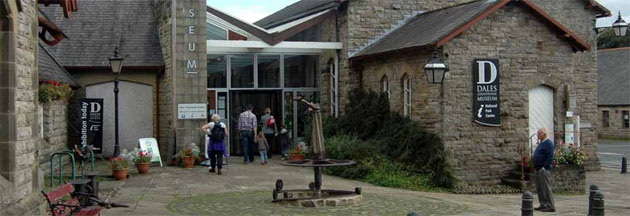
How it began
I received a telephone call from Fiona Rocher, Manager of The Countryside Museum in Hawes, to say that she would like to set up a meeting to discuss the possibility of including a piece of stone sculpture in her new Sculpture Trail at the Museum.
On the 27th February, 2012 I met Fiona at the Museum to discuss her ideas. It sounded like a very exciting project. Her plan was to use some of the space around the museum to make a walk, along which would be placed a variety of sculpture and artworks which had been inspired by the collection in the museum. It would be a way of showing visitors a different view of items at the museum, and maybe inspire them to look more closely and create further interest.
Fiona confirmed that she would like to commission me to make a stone piece for the Sculpture Trail. During this visit I took time to look myself, to thoroughly explore the different areas in the museum, and begin to form initial ideas about how I might realise the sculpture.
Visiting the Sculpture Trail Site
During the meeting with Fiona, she showed me the sculpture trail. We walked the circuit and she explained about the background to the trail and how it would help and enhance the experience visitors had whilst at the Museum.
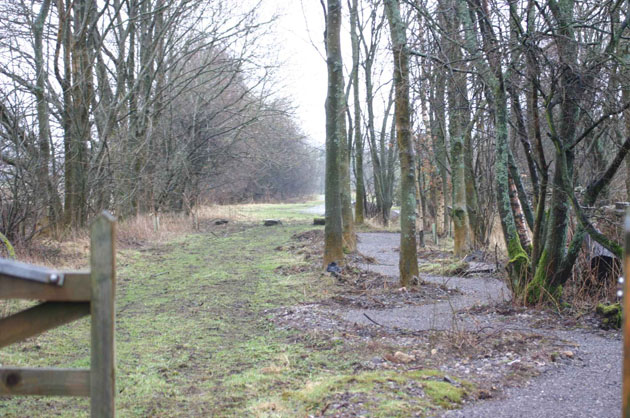
The Sculpture Trail – woodland area with wiggly, winding path running through.
A great deal of work had already been completed – paths were laid, edges, steps and bridges built, and walkways cleared. The spots where the sculptures were to be placed had been planned and mapped out, with different areas designated with different meaning and significance. Fiona gave me the Sculpture Commission Brief which detailed the purpose of each area and proposed sculpture.
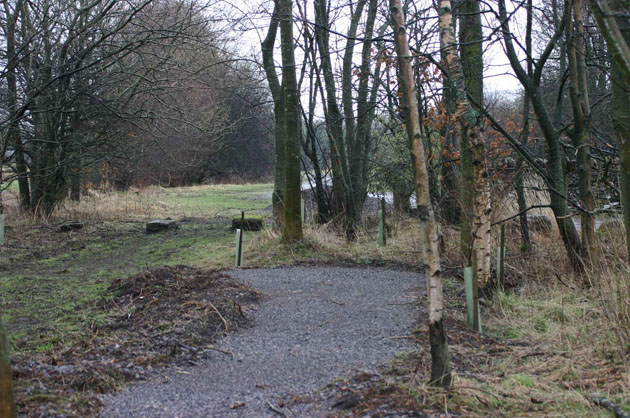
The Sculpture Trail – the path follows the curve of trees and new planting.
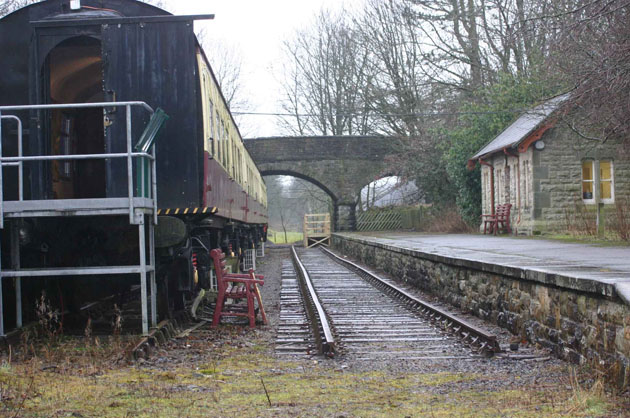
The Sculpture Trail – through the gate to the platform area, with view of the walkway under the bridge arches.
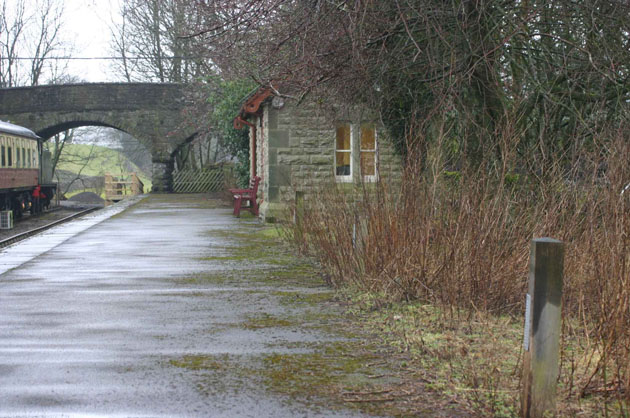
The Sculpture Trail – the Station waiting room and platform.
A number of these ‘areas’ immediately appealed to me in outline – but I first needed to visit the Museum collection and look in close detail and work out how objects may fit with the Brief and if I could design a stone sculpture based on them.
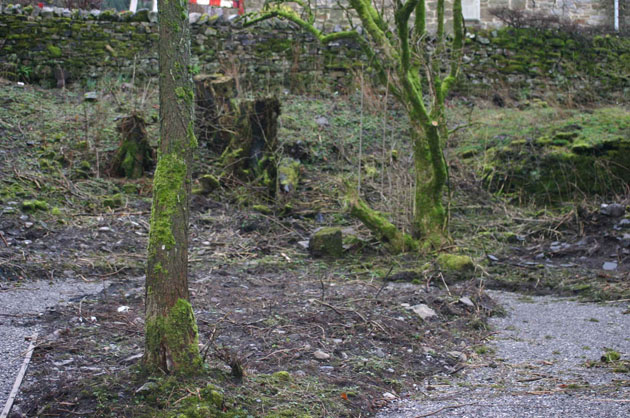
The Sculpture Trail – from the station, down a ramp and the path runs round in a sharp curve with beautiful enclave of wild undergrowth, with trees, and shady, mossy areas, banked up making a dramatic back-drop.
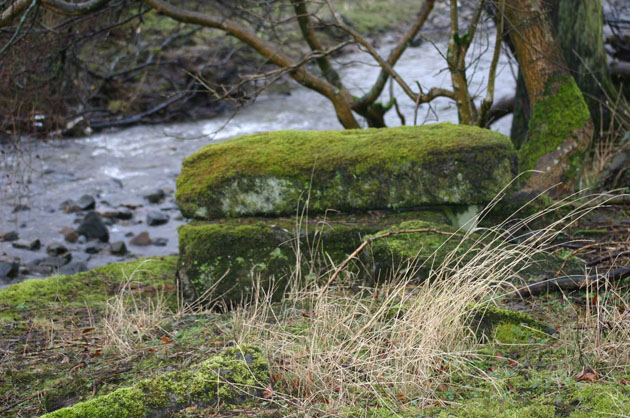
The Sculpture Trail – the path leads round to an open area, with view of the river, and vast foundation stones, faced and worked by stone cutters employed in the making of the railway.
Visiting the Museum
I’ve visited the Dales Countryside Museum a few times, running stone carving workshops there for visitors and the Young Archaeologists, but never looked properly at the collection.
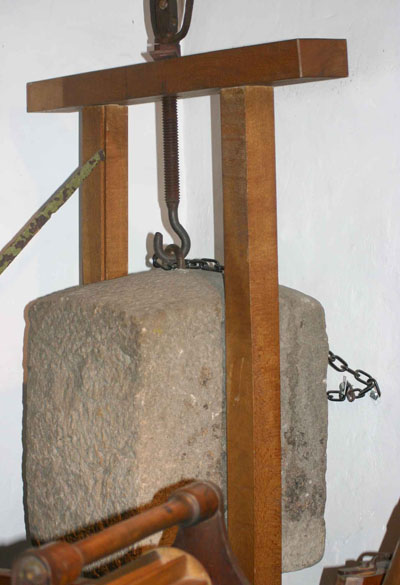
A cheese press made out of a great lump of stone, the weight of the stone block pressed the cheese.
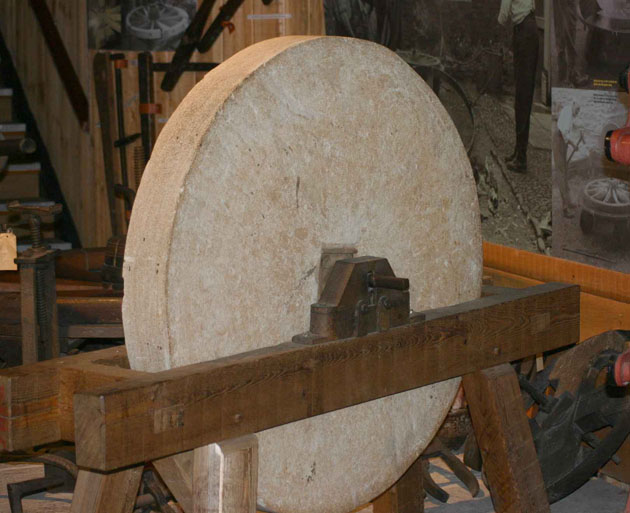
Knife sharpening stone.
In view of my commission for the Scupture Trail, it was time to take a closer look. The Dales Countryside Museum is a modern, bright building on the site of the old railway station and goods yard. The collection is housed in one of the old buildings off the main reception area, and once inside the entrance I found myself in semi-light, separated completely from daily distractions, the busy reception and shop and everything else but the items on display. They are warmly illuminated and I was drawn instantly to the objects in stone – a cheese press, grinding wheel, a knife sharpening wheel, fossils, rowling stone, Roman carved stones, the history in the area of quarrying and stone working tools, a mason’s mallet, Neolithic stone axes, Bronze Age arrowhead, various Stone Age tools and the geology of the area.
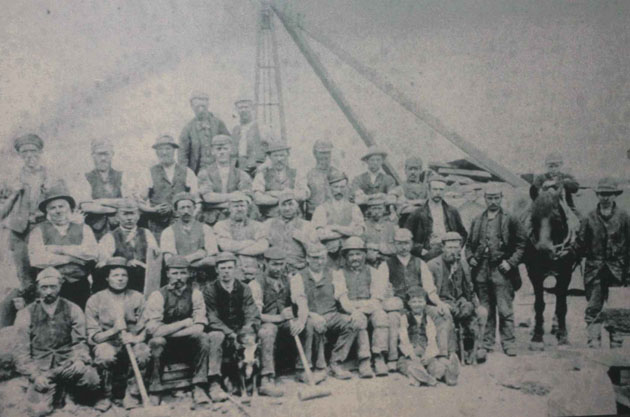
Quarrymen with lifting equipment and tools of the trade.
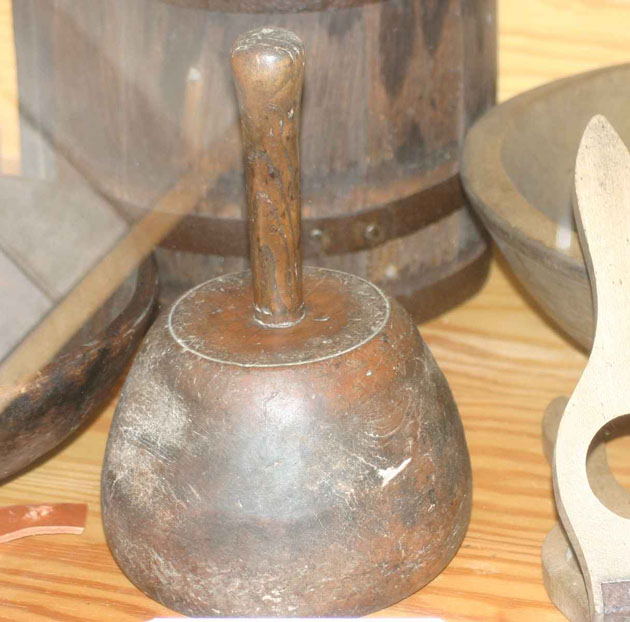
A wooden Mason’s mallet.
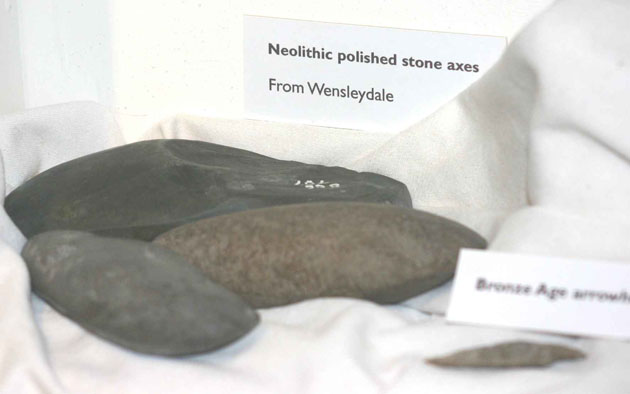
Neolithic polished stone axes.
The second time round, I went more slowly, reading more and finding myself fascinated by the knitting sticks, lead mining, tinsmith tools and working methods, farming implements, webbing manufacture, excavated bones, Viking finds, the landscape when man first inhabited the Dales, and the rows of shiny glass bottles with their matching vintage labels in the apothecary, with dreadful stories of compounds administered. I loved the agricultural tools, beautifully made, with worn wooden handles shaped by many hands.

Knitting sticks – the large one was called a ‘goose wing’ -they were held in the belt with a knitting needle inserted in the top and helped with knitting speed.
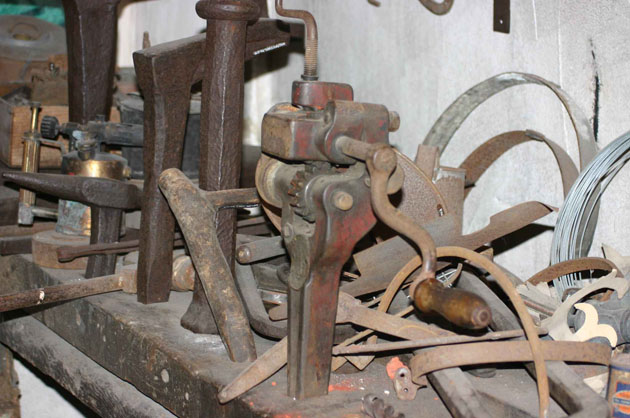
Tinsmith’s workshop
Lots of food for thought.
I drove away wondering how I could possibly decide on what to base my sculpture. Could I roll everything together in some way? Would I make a large single piece, or many smaller ones? Too many thoughts and ideas. I needed time to sift through, and hopefully the nucleus of an idea would emerge.
Forming Ideas
My visit to the Museum filled me with information and new knowledge. I felt excited and energetic about the sculpture commission and inspired by the collection of items I had seen. I also felt bewildered and a little over-whelmed by it all – not panicked, but knowing I had a serious pile of ideas to work through, consolidate and realise.
So, I made a sort of plan – to go through the items that inspired me most from the collection – examine them in detail – and see how the ideas generated by these fit with the Commission Brief, and if I could then create a sculpture based on those results.
Firstly then, to whittle down the ‘interesting items’ list!
List of Ideas
A difficult task, drawing up my list of ideas to work with, to take further and sketch into designs suitable for my stone sculpture.
The shortlist is:
- The geology of theYorkshire Dales
- The pre-historic landscape
- The Rowelling Stone
- The Fossils and Bones
One of the things that really struck me about items in the Museum, and in particular the items made of stone, is that they were all functional – they all had a useful purpose in the day to day lives of the people at the time they were made. I could see how the stone had been fashioned and worked, and why it had been made in that way, and why a particular stone was chosen. It made me feel very privileged that I had the luxury of making an item in stone, to join the collection (albeit outside), that was borne out of pure ‘fancy’ and not necessity. How lucky I am, to work in stone, carving objects of my own creation and whim.
Ideas – The Geology of the Yorkshire Dales
This was an obvious choice for me – because it involves so much about stone and appeals in every way, in that I want to celebrate stone in general and love to immerse myself in the subject and in learning more about it.
It fit perfectly with the criteria set out in the Sculpture Brief – particularly in relation to interpreting elements of the landscape and how we see it, how we have used it as a resource and left our marks on it.
I know very little about the stone in the Yorkshire Dales, so this was such an interesting exploration. Stone of course is the underlying material and what make the shape and look of the Dales, it creates the different habitats for wildlife and the specific look of walls and buildings, creating the character of the area. A particular attraction was the forms showing by the carboniferous limestone pavement. These shapes are just sculptural forms in their own right, and thoughts turned to standing stones with these beautiful soft, weather-worn undulations in them.
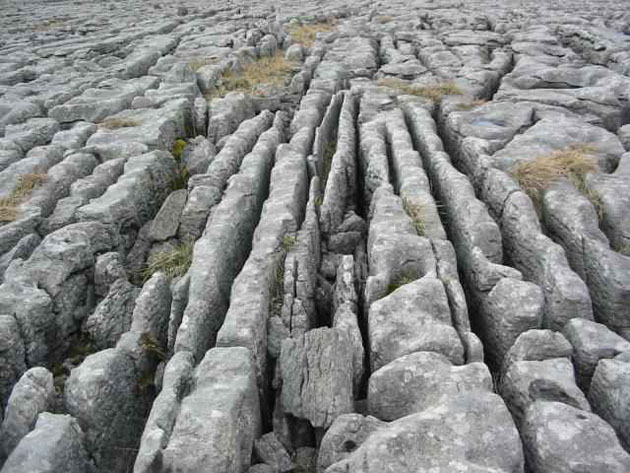
The actual formation many millions of years ago of the rocks of the Dales came about from sediments in water deposited over great periods of time – the limestone formed from shells and the skeletons of ancient animals – the sandstones, gritstones and shale formed from particles of rock carried by rivers and deposited. As the layers accumulated, the weight of them compressed those below and created the hard stones we now see. Earth movement uplifted, crushed and compressed the settled materials and gave us mountain and valley. Erosion, the weather and the Ice Age have also caused huge changes to the look of the landscape and how the stone appears.
The power and scale of these processes appeals and I wondered if I could sculpt a piece showing this magnificence and the resulting solidity.
The stone in the Dales has provided many with a livelihood over the centuries, through quarrying, wall, farm barn and villages and viaducts were built in stone, houses roofed with stone, it helped early man with tools, local limestone was burned to produce agricultural lime, limestone used for concrete aggregate, and nowadays the limestone is used for its calcium carbonate where demand by steel furnaces and the chemical industry remain high. I thought about a sculpture to represent this close working with stone and dependency on it.
The many different types of stone, and the fascinating way they are layered in the Dales made me think of perhaps using a variety of stones for the sculpture, finding ways to represent the many layers, beds and inclusions in the stones. There are also some limestones that take a polish, and I considered using these in the mix, to have a contrast of shiny and rustic finishes.
Ideas – The Pre-historic Landscape
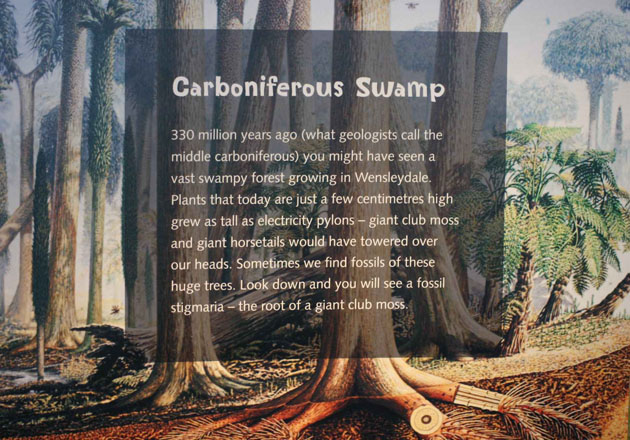
The Pre-historic Landscape.
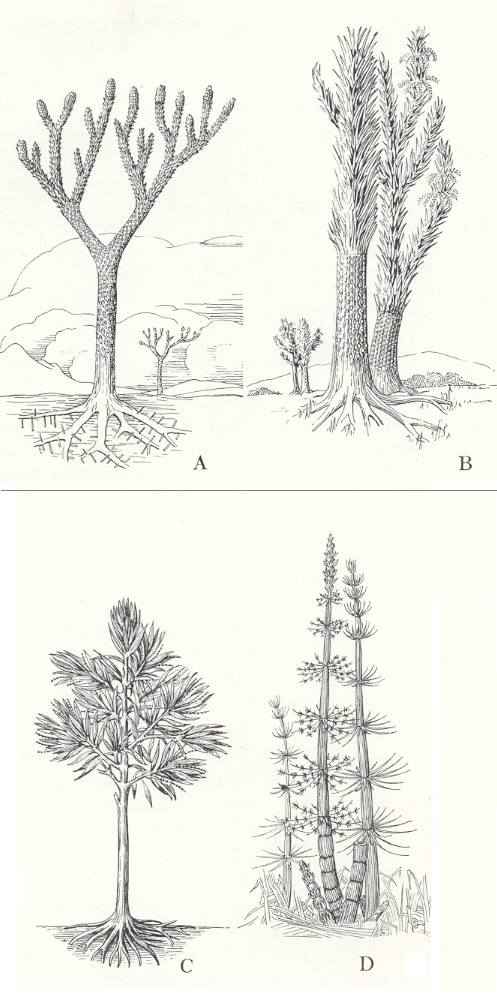
Plants to inspire a sculpture
I am fascinated by what the Dales would have looked like when man arrived and settled in the area. What did the landscape look like. What did it look like before the Ice Age? The Museum holds fossils showing us the types of plants that grew at that time, and also the animals that grazed, hunted or were hunted.

Sculptural shapes of plant material
I can picture the huge plants, in warm swampy conditions – giant plants growing in the lush tropical atmosphere. There are plenty images here to inspire a sculpture. The surface patterns of leaves, the over-size roots, the bulging organic shapes. All so appealing to me.
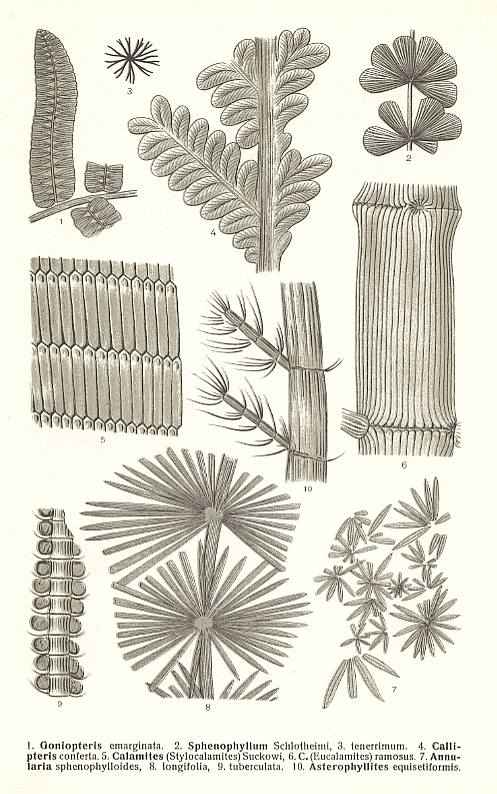
Organic shapes for sculpture

Ideas for surface design, finishing texture for my sculpture.
I feel particularly close, or connected in some way to this period in time, as it is the period in which the stones I now carve began to be formed – the material growing at this time is what made the stones that make up and shape the Dales. I work carboniferous limestone and carboniferous sandstone. I cut through with my chisel the flecks of coal (carbon), it colours and influences the stone. In the limestone there are inclusions, which were the small creatures living in the seas at the time, now compressed into a material I choose to work. I can smell the sweetness of vegetation and earth in sandstone, and the distant sea when working limestone, it is gassy and fishy.
Ideas – Rowelling Stone
When I saw the Rowelling Stone in the glass case I had no idea what it was. I had never heard of one before. It was displayed with other tools and instruments used in the veterinary care of animals. Most conjuring images of extreme cruelty rather than cure.
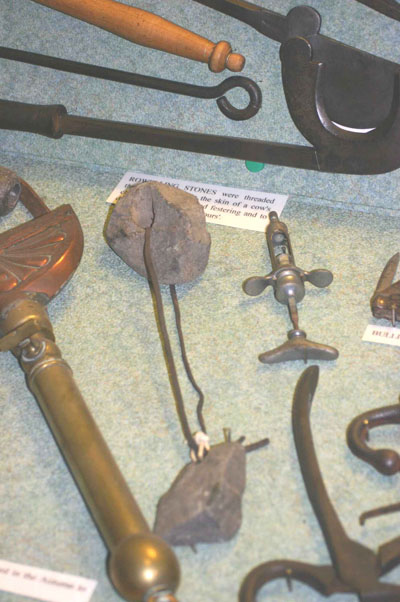
Rowelling Stone
In their book, Life and Tradition in the Yorkshire Dales, Marie Hartley and Joan Ingilby throw some light on the Rowelling Stones.
A general panacea adopted for the treatment of ailing cows was rowelling or reulling, also called pegging or seton, recommended by the nineteenth-century books on cattle doctoring. The principle involved the insertion of an irritant under the skin ‘to make the part laid open the seat of the disease’. Years ago all milk cows, especially those in poor condition, were regularly rowelled.
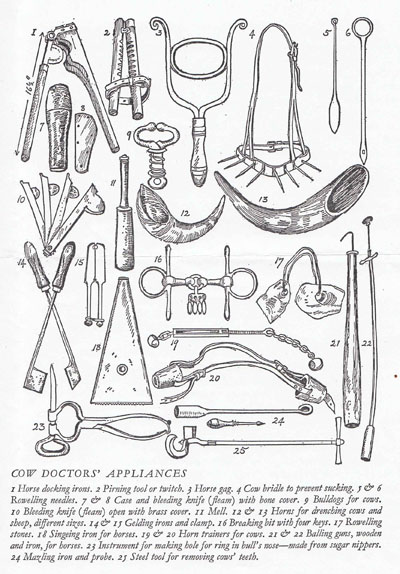
Number 17 shows the Rowelling Stones
One method, possibly the earliest, was to make a pocket in the skin of the chest of a cow, immediately in front of the foreleg by cutting a slit about an inch long, inserting a finger and opening out quite a large pouch between skin and flesh. Into this a few rolled up leaves of setter-grass (or felon grass) tied up tightly with string, were inserted for twenty-four hours – no more. Instead of setter-grass a piece of onion or a wad of cotton wool and course turpentine was sometimes used. Each day a ball of lard and salt was put in to keep the opening, which festered, running. At the same time a drink of felon was given.In another method a rowelling or setter’s needle was used. It either had a hole in the blade or a looped handle through which a tape or string was threaded. The needle was jabbed into the dewlap, slanted downwards under the skin about three inches, and a length of tape with a knot at one end drawn through. Then a second knot was made at the other end and the two ends tied together. Each day the tape was pulled so that the wound remained open festered, and ‘all the evil humours were drawn out’.
The Complete Farmer: or, a general Dictionary of Husbandry describes – ‘the rowel is to draw off all the bad and corrupt humours from the blood, by a sort of magic’
It was believed that the blood and other bodily fluids were regarded as “humors” that had to remain in proper balance to maintain health.
I can’t quite make out if the stones were threaded and pulled through to keep the wound open, or if the stones were used to keep the hole open by trapping them between flesh and skin to prevent the opening healing naturally. Sometimes a leather disc with a hole in was used, or a piece of bone.
Interestingly a dictionary describes rowelling – Variant of rowel
noun
a small, revolving wheel with sharp projecting points, forming the end of a spur
transitive verb roweled or rowelled, roweling or rowelling
to spur or prick (a horse, etc.) with or as with a rowel
The Northern Earth – Adventures in the Landscape tells of some fascinating traditions for medical care and magical cure.
More traditional were the four-leaf clover, rowan sprig or holed stone placed in the shed. The naturally holed stone, sometimes called a hag, holey or dobbie stone, was widespread in farmyards. It was thought to offer protection against all kinds of unworldly misfortunes, from the evil eye (which the holed stone might be thought to resemble) to hag-riding (when beasts were found sweaty and tired in the morning, it was attributed to them having been ridden hard by witches or fairies during the night). Limestone was used in the Dales, but flint was especially efficacious; as John Aubrey declared “To hinder the Night Mare they hang on a String a Flint with a hole in it (naturally) by the manger; but best of all, they say, hung about their necks…”. Often attached to the keyring for the animal sheds (where the iron of the keys added an extra element of protection), or suspended just above an affected animal, it can still be seen on some farms.

The use of a naturally holed stone was widespread as a protective amulet for humans and animals.
Other techniques were legion. In Yorkshire, cattle were regularly rowelled to maintain their condition – this involved opening the cow’s flesh, either a pocket in its chest or holes through the dewlaps, and keeping the wound open until it festered. A leather or tarred twine cord was tied through the dewlap holes, sometimes with a holed stone attached; the running wound – which did not seem to cause discomfort, but stank – would draw out ‘the evil humours’ preventing a cow from prospering; elsewhere, a scopperil – a piece of wood with an amulet hung from it – was used, specifically for the ‘quarter-ill’.
My thoughts were that the shape of the stone, with hole through could be represented in a sculptural form, perhaps with something threaded through – I have always rather wanted to carve chain links, as something of a skill challenge – and this thread running through stones holds the same attraction. I’m fascinated and horrified at the same time, by reading about rowelling and early medical and veterinary practice.
There is a lot to work with here.
Ideas – Fossils and Bones
The Museum holds a wonderful collection of bones and fossils – telling of a time when man first arrived in the Dales, giving evidence of human activity and animals present since the Ice Age. Archaeological evidence shows that man had to respond to rapidly changing climates and developing woodland environments. To do this he had to adapt his hunting technology. He changed from using spears to hunt large herd and fur bearing animals (including reindeer, wild horse and arctic fox) present during the arctic tundra conditions at the end of the Ice Age (end of the old Stone Age), to using flint barbed archery equipment to hunt elk, red deer, roe deer, wild ox and wild pig in pine, birch and hazel woodland during the Middle Stone Age. The final transition came during the Neolithic/Bronze Age times when man moved from hunting and gathering, to become pastoral and arable farmers within a deciduous forest landscape.

The bones and teeth of these animals are in the collection, giving an accurate account of the animals and wildlife present. The stone of the area is full of traces of what went on in times long past – I began thinking about how I could perhaps make a fossil type sculpture of a creature which was an amalgam of many animals, using the parts that most appealed from the pieces in the collection.
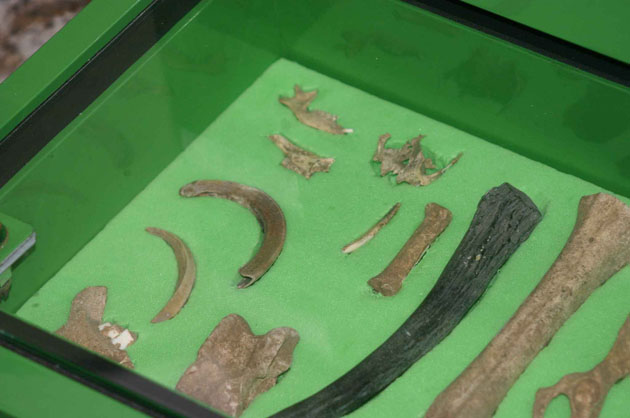
It made me reflect on how I view wildlife around me now – I enjoy watching and learning and offering help in conserving, but early man had quite a different view. He needed food and warmth and used the animals around him for this. There was a much closer affinity with nature in general, and a huge respect for the natural world and a deep spiritual understanding.
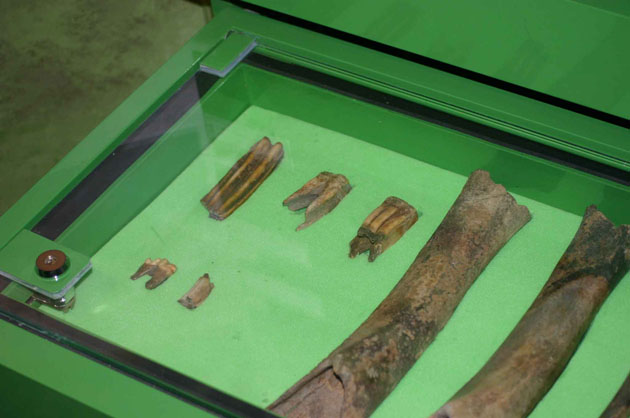
I was very taken with the Aurochs horn and imagined this beast roaming in herds and being hunted for food and hide. I wondered what it must have looked like.As a sculptor I am hugely inspired by the wildlife around me, and many of my carvings are of animals and birds – so these bones, teeth and fossils really excited ideas for a sculpture. I wondered if I might populate the wooded area of the Sculpture Trail with animals as once they had roamed the woodlands many years ago.Even the bone shapes themselves, and some of the teeth too were beautiful shapes which could be the basis for a more abstract sculpture.
Decision Time
All the areas that I chose to shortlist brought their possibilities for my sculpture, but after a number of sleeps and looking at where my heart lay, I knew I had to choose the Bones and Fossils and carve an animal of sorts.
I checked this idea fit with the criteria and objectives of the Dales Countryside Museum in creating the Sculpture Trail.
Initially, in my mind, the scale of the piece was enormous! But time to complete the commission and the budget kept these notions in check.
From the bone evidence of which animals were in the landscape when Homo habilis, Homo erectus and Homo sapiens walked the Dales we see that Mammoths roamed the lands, Cattle, Deer, Elk and Wild Pig. The Aurochs horn raised a number of questions for me. I wanted to know more about this animal and so it became my focus.
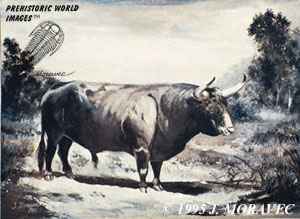
BOS PRIMIGENIUS – this beast is the ancestor to most of our moderncattle and measured up to ten feet long. First domesticated some 6000 years ago. It ranged North Africa, Europe andAsia.
Making this my choice seemed to pull bits from all four of the areas, they overlapped in part anyway, but to me it seemed the Aurochs connected them all.

Aurochs Sculpture
The making of sculpture for me starts with investigation – I need to immerse myself as much as possible in the subject matter. I need to know about the subject I’m carving, know it as intimately as I can, and this helps my ability to carve.
Probably the things that initially drew me to the Aurochs were its size, power and ancientness and thus I felt carving it in stone, creating a sculpture based on it, was fitting – as stone too is ancient, powerful and vast.
I needed to know all things Aurochs.
That I had seen the horn which was at one time proudly held on the head of an Aurochs was thrilling, to think that it was live and roaming, breathing and snorting, protecting its herd, that its hooves pounded the earth – it possibly walked over the very ground where my sculpture would eventually sit.

The Aurochs horn at the Dales Countryside Museum which ultimately inspired my subject choice for the commissioned sculpture for the Hidden Secrets Sculpture Trail.






























